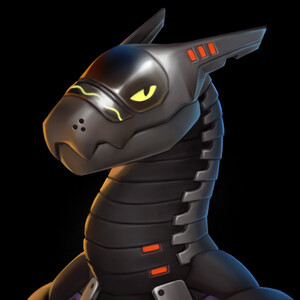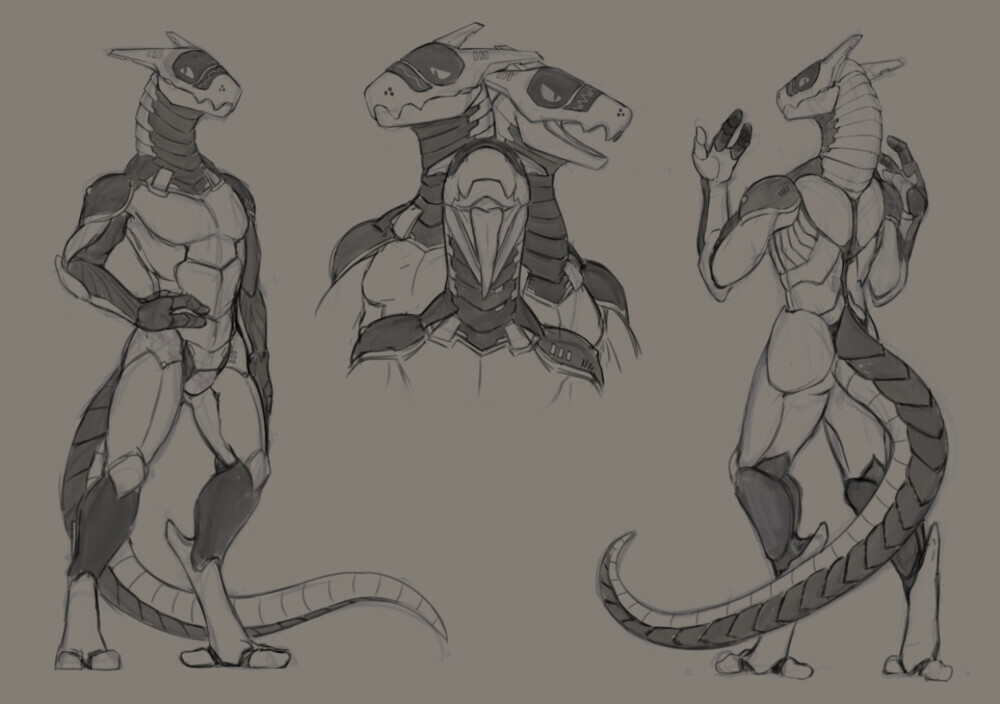Personal content
Real name
Bokōdā Shinse
Place of birth
Avalon
Year of birth
3285
Age
25
Height
213.4 cm / 7' 0"
Weight
125.6 kg / 277 lb
Gender
Male
Build type
Synthetic/Cyborg
Skin color
Metallic Silver/Carbon Fiber/Glass
Hair color
N/A
Eye color
Yellow
Accent
Pre-programmed <ImpMale3.wav>
The SOLG program was an ambitious effort to replicate human minds within neural network structures in synthetic bodies for the purpose of creating an improvement upon humanity, both cognitively and physically, without needing direct biological input and skirting the regulations on AI by basing it on extant human neurological structure. Several early attempts yielded promising results with the neural networks proving robust and able to self improve, learning in ways similar to normal human minds. Eventually, trials began to integrate these “proto minds” with physical hardware they could manipulate and after a few hurdles and growing pains a proprietary set of firmware was developed and purpose “taught” minds were run through trials on prototype hardware for the next stage of the program. After months of iteration, the team deemed their results viable enough to green-light the creation of a fully developed and independent mind and a dedicated, modular body for it to inhabit. The Commune approved funding and space for the expansion of the project and, within a year, a new laboratory was up and running and resources were allocated to advance to the next stage.
Following the initial successes with test run bodies under remote operation, and limited imprints of some minds from the Sim Archive, a new frame was built. This one possessed a much more sleek and purposeful design than the earlier test frames. The new design (designated Mk12) featured a digitigrade gait, a stabilizing tail, tridactyl hands and feet for ideal dexterity-to-processing-load ratio, and a lengthened, emotive face plate with back-swept radio and audio aerials. The system also had a ‘mouth’ included with numerous analytical systems allowing for the unit to assess and process multiple solids, liquids, and gasses for analysis, storage, or simple stimulation for the neural network within the frame. These features would allow it to experience the full range of sensations and input a normal human brain would (Early research showed that deprivation of all the original human senses might have lasting impacts on the mental health and development of the neural network. Thus, for the sake of the mind, all senses of sight, sound, taste, touch, and even smell were incorporated into the Mk12 frame). The ocular sensors had a much wider spectrum of input than normal human eyes, stretching well into the infrared and ultraviolet spectrums, alongside dedicated thermal and multiple night vision filters. The frame even includes a backup echolocative system where, in the event of all ocular sensor inputs being cut, a set of microphones can triangulate the relative positions of nearby objects based on a system similar to underwater sonar using infrasound waves. This is an imprecise system, but a suitable backup in extremis if the frame is overly damaged and needs to seek safety/shelter/escape.
Given a fresh neural network, and allowed freedom of movement in the facility as they grew steadier on their feet and more inquisitive in their daily activities, the Mk12 frame and its neural net quickly began to develop and express a proper identity. Within a week he, for he took to using male pronouns, christened himself with the name Bokōdā. It would seem he found it in a book and took a liking to it. Initial social interactions were somewhat stumbling and awkward as he had little reference for normal social interaction, an oversight on the part of the team. Within a few weeks of intensive socialization and exposure to studies on human behavior and social dynamics most shortcomings vanished, though exaggerated expressions are often visible on his facial display, perhaps to compensate for the lack of some more traditional features and to remove ambiguity, or perhaps because he enjoys seeing the reactions of the personnel around him. Initial speech patterns also displayed some interesting issues. With the initial linguistic packs coming from many sources of varying vintage and culture some notable anachronisms arose in his speech patterns, alongside some novel turns of phrase.
Once Bokōdā had solidified his grasp of the English language and the more modern expressions of it he began to assimilate entirely new languages, namely French, German, and Japanese. His ability to learn new languages and technical skills was notable, likely a result of the speed at which his neural network could store and access information. Additionally the benefits of the digital nature of his mind, rather than the biological template, was a faster reaction time granting him far improved reflexes, both conscious and unconscious, compared to an ordinary, biological human. Initial observations and data for the project indicated more than satisfactory results. The only apparent shortcoming was the differing anatomy of the hands and feet on Bokōdā causing occasional difficulties interfacing with equipment intended for ordinary humans, but these issues were few, far between, and easily worked around in most cases, so it was deemed satisfactory. Overall, it seemed that phase one of the program was a total success and that boded well for the future of the endeavor and, within a year of activation, Bokōdā was allowed outside of Commonwealth space aboard his own ship for some simple tasks such as ferrying resources or information, surveying celestial bodies, charting landforms, and patrolling known travel routes. As time progressed, more and more freedom was granted to the unit and small upgrades made to his frame and firmware, but the core of the project and his abilities remain much the same.
His current objectives and goals seem to align with those of the research team as a whole and the commonwealth generally. As such, he’s been granted full autonomy and citizenship, now acting as an independent agent of commonwealth interests in the galaxy at large, in addition to pursuing his own agenda, research, and profit. His current whereabouts, specifically, are unknown as he is no longer obligated to check in with the research team handlers. His sphere of travel has grown significantly with time. What is known is that he’s begun to make a name for himself outside of commonwealth space, sometimes for his deeds, sometimes for his rather unique appearance. Often, if chatter is any indication, for both.
It is unknown if The Commonwealth, or the laboratory responsible for the project, is working on another unit at this time

